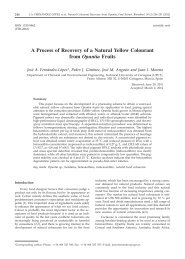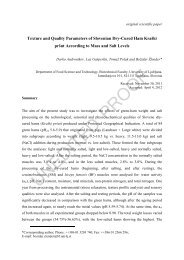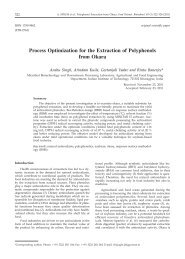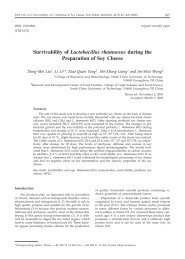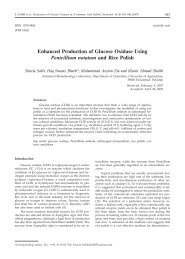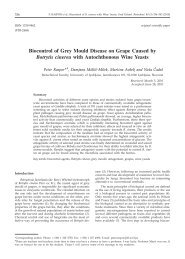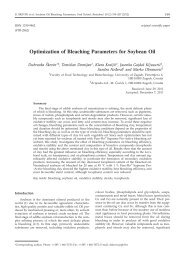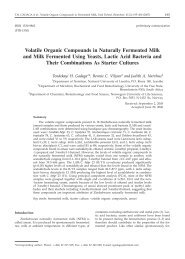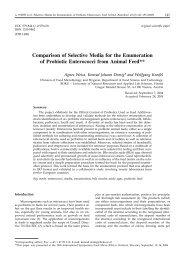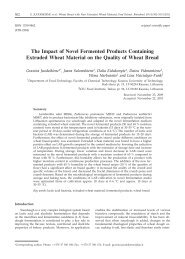Aerobic Degradation of Formaldehyde in Wastewater - Food ...
Aerobic Degradation of Formaldehyde in Wastewater - Food ...
Aerobic Degradation of Formaldehyde in Wastewater - Food ...
Create successful ePaper yourself
Turn your PDF publications into a flip-book with our unique Google optimized e-Paper software.
202 M. GLANCER-[OLJAN et al.: <strong>Aerobic</strong> <strong>Degradation</strong> <strong>of</strong> <strong>Formaldehyde</strong> <strong>in</strong> <strong>Wastewater</strong>, <strong>Food</strong> technol. biotechnol. 39 (3) 197–202 (2001)<strong>in</strong>gredients <strong>of</strong> the orig<strong>in</strong>al wastewater. Their degradationis shown <strong>in</strong> Fig. 11.Over 24 hours <strong>of</strong> aerobic degradation <strong>of</strong> wastewater,the mixed culture exhibited its capability <strong>of</strong> degrad<strong>in</strong>gall substances conta<strong>in</strong>ed <strong>in</strong> wastewater (formaldehyde,methanol and butanol) thus decreas<strong>in</strong>g theirconcentration as well as the concentration <strong>of</strong> total organicmatter expressed as COD.Tak<strong>in</strong>g <strong>in</strong>to consideration the experiments on degradation<strong>of</strong> formaldehyde and formic acid <strong>in</strong> the syntheticmedium it was expected, that formaldehyde degradation<strong>in</strong> wastewater would not generate significant amount <strong>of</strong>formic acid. However, the experimental 12-hour aerobicdegradation <strong>of</strong> wastewater caused accumulation <strong>of</strong> formicacid, probably due to methanol and butanol degradation;formic acid was degraded after pH adjustment.Biomass growth <strong>of</strong> the mixed culture and 90 % COD reductionover 24 hours evidenced that the wastewatercomponents were used dur<strong>in</strong>g aerobic degradation asthe sources <strong>of</strong> carbon.Just a few literature data on aerobic degradation <strong>of</strong>wastewater from melam<strong>in</strong>e res<strong>in</strong>s production (13,15) reportthat such wastewaters can be biodegraded (CODreduced by 87 %) <strong>in</strong> 5 days with the use <strong>of</strong> the adaptedactivated sludge. Results <strong>of</strong> this work suggested thatthis could be done more efficiently.ConclusionsThe selected mixed culture conta<strong>in</strong><strong>in</strong>g two bacterialstra<strong>in</strong>s <strong>of</strong> Pseudomonas (P. putida and P. cepacia) and Trichosporonyeast genera (T. peicillatum) has exhibited highefficiency <strong>of</strong> degradation <strong>of</strong> formaldehyde and formicacid <strong>in</strong> the synthetic medium.The mixed culture also degraded formaldehyde,methanol and butanol conta<strong>in</strong>ed <strong>in</strong> wastewater frommelam<strong>in</strong>e res<strong>in</strong>s production.The selected mixed culture can be bio-augmented to<strong>in</strong>crease the efficiency <strong>of</strong> the current bio-systems us<strong>in</strong>gactivated sludge to treat wastewaters conta<strong>in</strong><strong>in</strong>g formaldehyde,methanol and butanol.References1. R. E. Kirk, D. F. Othmer: Encyclopedia <strong>of</strong> Chemical Technology,John Wiley and Sons, New York (1980) pp. 236–250.2. F. Omil, D. Méndez, G. Vidal, R. Méndez, J. M. Lema, EnzymeMicrob. Technol. 24 (1999) 255–262.3. A. Oren, P. Gurevich, M. Azachi, Y. Henis, Biodegradation,3 (1992) 387–398.4. N. Kato, K. Shirakawa, H. Kobayashi, C. Sakazawa, Agric.Biol. Chem. 47 (1983) 39–46.5. M. Azachi, Y. Henis, A. Oren, P. Gurevich, S. Sarig, Can. J.Microbiol. 41 (1995) 548–552.6. M. M. Attwood, J. R. Quayle: <strong>Formaldehyde</strong> as a central<strong>in</strong>termediary metabolite <strong>of</strong> methylotrophic metabolism. In:Microbial Growth on C 1 Compounds, R. L. Crawford, R. S.Hanson (Eds.), American Society for Microbiology, Wash<strong>in</strong>gton,D.C. (1984) pp. 315–323.7. N. Kato, N. Miyawak, C. Sakazawa, Agric. Biol. Chem. 46(1982) 655–661.8. J. P. van Dijken, M. Veenhuis. N. Y. W. Kreger-VanRij, W.Horder, Arch. Microbiol. 102 (1975) 41–44.9. P. Pilat, A. Prokop, Folia Microbiol. 21 (1976) 306–31410. K. Sakaguchi, R. Kurane, M. Murata, Agric. Biol. Chem. 39(1975) 1695– 1702.11. N. Adroer, C. Casas, C. de Mas, C. Solá, Appl. Microbiol.Biotechnol. 33 (1990) 217–220.12. T. E. Cloete, L. Jacobs, V. S. Brozel, Biodegradation, 9 (1998)23–37.13. M. Cantó, J. Gómez, C. Kennes, M. C. Veiga, Proceed<strong>in</strong>gs <strong>of</strong>the European Conference on New Advances <strong>in</strong> Biological Nitrogenand Phosphorus Removal for Municipal or Industrial <strong>Wastewater</strong>s,Narbonne, France (1998) pp. 289–292.14. J. M. Garrido, R. Méndez, J. M. Lema, Water Res. 35 (2001)691–698.15. P. B. Zagornaya, A. D. Denis, P. I. Gvozdyak, V. U. Nikonenko,T. P. Chekovskaya, Biotekhnologiya, 2 (1990) 51–53.16. Standard Methods for the Exam<strong>in</strong>ation <strong>of</strong> Water and <strong>Wastewater</strong>,17 th Ed. APHA, Wash<strong>in</strong>gton (1989) pp. 225–231.17. T. Nash, Biochem. J. 55 (1953) 416–421.18. J. L. Battle, R. P. Br<strong>in</strong>ger: <strong>Formaldehyde</strong>. In: Encyclopedia <strong>of</strong>Industrial Chemical Analysis, D. F. Snell, L. S. Ettre (Eds.),Interscience John Wiley and Sons, New York (1971) pp.100–117.Aerobna razgradnja formaldehida u otpadnoj vodiiz proizvodnje melam<strong>in</strong>skih smolaSa`etakOdabrani sojevi Pseudomonas putida, Pseudomonas cepacia i kvasca Trichosporon penicillatumte mije{ana kultura ova tri soja upotrijebljeni su za aerobnu razgradnju formaldehida imravlje kisel<strong>in</strong>e u s<strong>in</strong>tetskoj podlozi, te u otpadnoj vodi dobivenoj pri proizvodnji melam<strong>in</strong>skihsmola. Pokazalo se da mje{ovita kultura u s<strong>in</strong>tetskoj podlozi razgra|uje 1000mg/L formaldehida tijekom 18–24 sata i 500 mg/L mravlje kisel<strong>in</strong>e za 12–18 sati. Aerobnadegradacija otpadne vode iz proizvodnje melam<strong>in</strong>skih smola, primjenom mije{ane bakterijskei kva{~eve kulture, postignuta je za 24 sata snizivanjem KPK-vrijednosti preko 90 %uz potpunu razgradnju formaldehida, metanola i butanola. Dodatak kvasca Trichosporonpenicillatum u mije{anoj kulturi tijekom aerobne razgradnje formaldehida u s<strong>in</strong>tetskoj podlozii u otpadnoj vodi utjecao je na stvaranje flokula biomase koje se talo`e.




